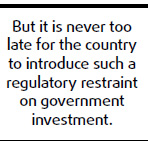Opinion
Investment efficiency
(China Daily)
Updated: 2010-01-09 07:41
 |
Large Medium Small |
The draft regulation on government investment that the State Council issued on Thursday to solicit public opinion was badly needed to make the "visible hand" a sensible one as well.
Policymakers must understand that better regulated government investment is essential both for the ongoing efforts to overcome global recession and the long-term health of China's economy.

The $586-billion stimulus package that the Chinese government rolled out in November 2008 in response to the global financial crisis has worked its magic by cushioning the Chinese economy against the worst global recession in decades.
In the absence of an increase in domestic consumption to fill the gap created by dropping orders for Chinese goods from developed economies, government-led investment has almost single-handedly pulled the world's third largest economy back on the track of fast growth.
China's economic growth has not only rebounded from a decade-low of 6.1 percent in the first quarter of last year to 8.9 percent in the third, but it is also widely expected to retouch double-digit growth in the following quarters.
Though the huge two-year stimulus package continues to help lift economic growth, it is high time a thorough review of the quality and efficiency of the government-led investment projects was conducted.
The draft regulation on government investment has seemingly not come early enough to forestall any rush in the massive stimulus package, which can affect the quality or long-term returns of the government-led investment projects.
But it is never too late for the country to introduce such a regulatory restraint on government investment, which is likely to increase further as government revenue keeps rising.
It is true that government investment is playing a larger role than private investment in fighting the global financial crisis. But that does not mean the visible hand should always assume a role bigger than market forces in allocation of resources.
If a broad-based recovery is to take root, policymakers have to focus more on the efficiency and less on the size of government investment while doing their best to boost private investment and consumption.














